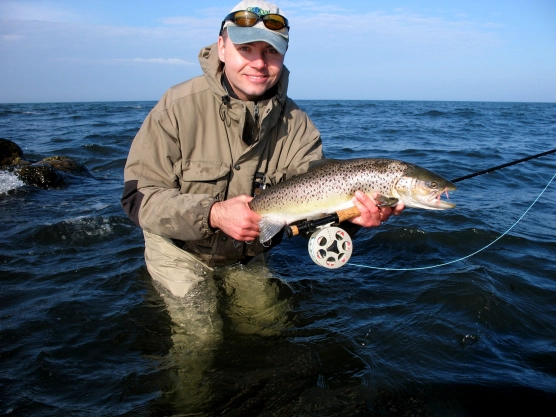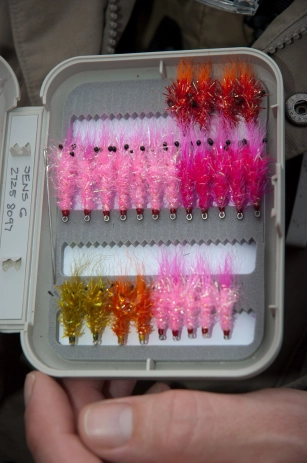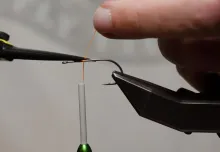This article in the series on fly patterns for particular coastal water conditions in the Baltic deals with the season upon us: winter.
Once the water starts getting cold, coastal sea trout fishing slows down significantly. The fish use way less energy, eat less and simply move less. That of course influences their hunting behavior. For sheer physical reasons they are slower and fishing for them requires conviction and dedication – some some flies that can scream: "here I am!".
With the winter closing in in the Baltic, this second installment of "Baltic flies for..." concentrates on cold water.
What's cold?
And just to be clear: cold is like really cold, meaning water temperatures below 5-6 deg C or about 41-43 deg F and down to freezing. Even though we might consider 10-12 deg C or about 50 F quite cold, that's actually a very comfortable temperature for trout, and not nearly cold enough to make them docile or "lazy".
The fish are still active in the cold water and want to feed if they can, but the cold water lowers their metabolism and need for energy as well as their willingness to move fast.
Fishing in water this cold typically takes place on "warm" days, mainly in sunny and calm weather, and you will often be fishing fairly shallow water for fish moving slowly. A fly that gets down, but still can be fished in a moderate tempo and has some color and/or flash, is often the key. Since the fish aren't really in an eating mood, some provocation can trigger attacks. The flies selected here are all tied to be flashy and colorful, and are in most cases quite unlike the flies usually used for sea run trout.
When and where
So winter fishing in the Baltic is usually considered best on sunny days. Calm days work, but a breeze isn't bad because it stirs the surface and can move the water. If it's freezing cold, you may opt for a shore with offshore wind. The wind will move out the almost freezing surface water and bring in water from deeper parts, often being significantly warmer than the surface water close to the beach.
In calm conditions, you can concentrate on areas with shallow water and dark bottom. Dark silt, weed or stones will warm up slightly in the sun, and get the smaller animals like shrimps and scuds on the move. Combined with just a bit of warmth in the water, this entices the trout to start feeding.
Martin Joergensen
Break the rules
Never say never, and don't stay on land because the classic winter conditions aren't met. The sunny conditions are often preferred by the anglers, but not necessarily by the fish. Great winter fish have been caught in turbulent water under a lead gray sky on bitterly cold days, so if you feel like fishing on a winter's day and the water is fishable, please go! Fish over light bottom, fish in onshore wind, fish when it seems impossible to wring a fish out of the water. Fish don't go on shore in the winter! They are still in the water and still need to eat now and then.
Cold water tactics
As mentioned above, slow can be a key. It's not always the case, and you can mostly start fishing as you usually do: a floating or slowly sinking line, fairly light flies fished at normal speeds, and not necessarily the brightest ones in your box.
But if nothing happens and you think that fish might be around, it's time to adjust some factors. I usually change to a bright fly first. Same basic size and shape that I usually fish, but with more flash and color. Patterns such as a Polar Magnus or Disco Frede can trigger some action. Even brighter weapons may need to come out, and Glitter Shrimps, Christmas Trees, Flames or similar constructions may be the key.
A little weight on the fly to get it down may work, or you can consider a sinking line or leader.
Cast out and leave the fly to sink before retrieving it slowly, maybe using figure-of-eight retrieve or simply really slow pulls.
Winter water is often clear and even very calm on the nice days, so make sure to cast with as little splashing as possible, presenting the fly on a nicely stretched leader - and leave it for a bit, letting things calm down before slowly bringing it back.
Takes can be slow and undeceive, and if you feel anything fishy, just halt the retrieve and let the fly hover before stripping again. The fish may come back for a second try.
The Flame
This is Danish Martin Hedegaaard's variation of the The Christmas Tree, tied with very bright pink flash tubing and a set of heavy eyes. The fly is often tied using a fluorescent flash material, giving it an almost unearthly shine in the water – hence the name.
Using other colors of flash can work: purple, black, orange, olive. The tying method is the same as for the Christmas Tree just adding bead chain eyes.
Glitter Shrimp
A very classic Danish shrimp imitation, so colorful and bright, that it doesn't look much like a shrimp at all. Never the less the fish like it, and it has proven its worth in both dirty and cold water. It's usually tied in pink or orange, but sometimes also seen in slightly more subdued colors like tan, gray or pale yellow.
See how to tie the Glitter Shrimp here.
Polar Magnus
The pink or red hackled Magnus is a well known and popular winter sea trout fly. The Magnus is a universal killer for sea trout, and this slightly tuned version has an edge on the purely gray version.
Joergen's Demon AKA Joergen's Devil
I've had great success with this little fly in cold water. It's visible, lightweight and a great fly to fish slowly. You can vary the shine and color, but I still like the original with the braided tinsel body and orange flash chenille front. It has been mentioned many times on the site and seen in many pictures. I also put it in my book "Favorite Flies for Baltic Sea Trout", but now it gets its own real pattern description with a full step-by-step. It was originally tied many years ago by my good friend Joergen Nielsen AKA "Old Joergen" and was inspired by the Big Hole Demon.
Tying steps
|
|
|
|
|
|
|
|
|
|
|
|
|
|
|
|
|
|
|
|
|
|
|
|
|
|
|
|
|
|
|
|
|
|
|
|
|
|
|
|
Martin Joergensen
Hand picked for this article
- Log in to post comments

























































